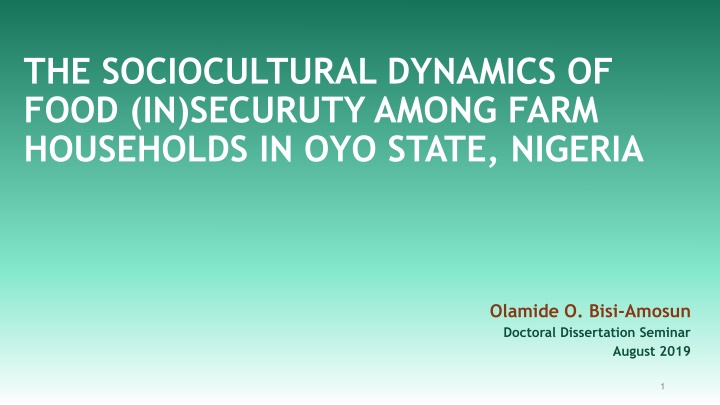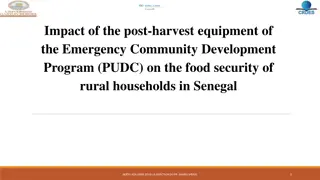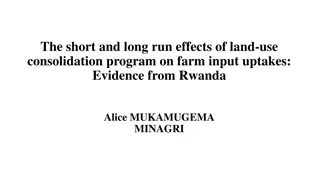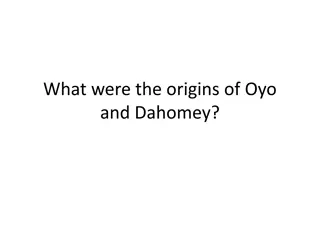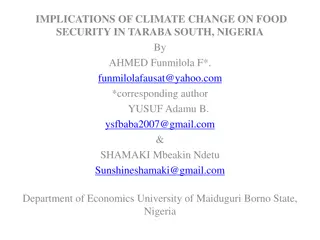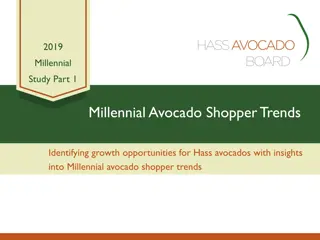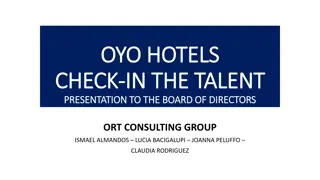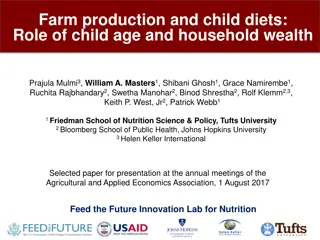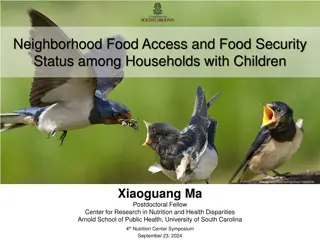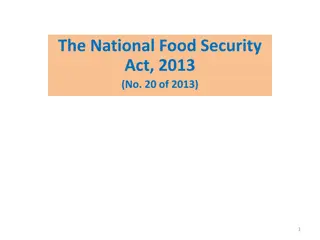Sociocultural Dynamics of Food (In)security Among Farm Households in Oyo State, Nigeria
This doctoral dissertation seminar explores the sociocultural dynamics of food security among farm households in Oyo State, Nigeria. It delves into demographic characteristics, food production and consumption patterns, socio-cultural drivers of behaviors, and factors influencing food security. The study highlights the importance of understanding cultural contexts for tackling food insecurity challenges.
Download Presentation

Please find below an Image/Link to download the presentation.
The content on the website is provided AS IS for your information and personal use only. It may not be sold, licensed, or shared on other websites without obtaining consent from the author.If you encounter any issues during the download, it is possible that the publisher has removed the file from their server.
You are allowed to download the files provided on this website for personal or commercial use, subject to the condition that they are used lawfully. All files are the property of their respective owners.
The content on the website is provided AS IS for your information and personal use only. It may not be sold, licensed, or shared on other websites without obtaining consent from the author.
E N D
Presentation Transcript
THE SOCIOCULTURAL DYNAMICS OF FOOD (IN)SECURUTY AMONG FARM HOUSEHOLDS IN OYO STATE, NIGERIA Olamide O. Bisi-Amosun Doctoral Dissertation Seminar August 2019 1
COMMITTEE MEMBERS Dr. Linda J. Pfeiffer Dr. Jennifer L. Johnson Dr. Mark A. Russell Dr. Mark A. Tucker 2
BACKGROUND Smallholder Farm Household AVAILABILITY FOOD SECURITY UTILIZATION ACCESS STABILITY 3
A GLOBAL PARADOX 7 Billion 2 Billion 5
PROBLEM STATEMENT The continued adoption of an economic approach to food security had led to failure of many initiatives due to limited understanding of the cultural context in which food insecurity exists and persists. 6
RESEARCH QUESTIONS RQ1. What are the demographic characteristics of farm households in Ago- Amodu and Elepo Villages of Oyo state, Nigeria? RQ2. What foods do farm households produce and consume, and do they differ by village? RQ3. What socio-cultural factors drive the food production behaviors of farm households? RQ4. What socio-cultural factors drive food consumption and distribution within farm households of each village? RQ5. How do socio-cultural factors influence food security in each village? RQ6. Are there common socio-cultural factors that influence food security between villages? 7
CONCEPTUAL FRAMEWORK Economic Food Production Nutritional Status of Factors Food consumption farming households Income Dietary Diversity Intra-household food distribution Cultural Factors Norms Values Beliefs Control Variable Household Characteristics Household size Livestock ownership Primary source of food procurement Marital status Intervening Variables Health Status Medical History 8
THEORETICAL PERSPECTIVE Giorgi s Descriptive Phenomenology INTENTIONALITY REDUCTION PHENOMENOLOGY 9
CONTEXT Nigeria 70% of population depends on agriculture 90% subsistence 22% of GDP Low mechanization Rain-fed Average land size = 0.5 hectares Food Security 27-34% of population experience food insecurity 50% experience food shortage at least once a year Second highest number of stunted and wasted children globally Oyo State Highest prevalence of child stunting Highest percentage of undernourished women (in Southwestern Nigeria) 10
METHODOLOGY Purposive Sampling Constructs Marital Status, Type of Marriage, Food Production 2 Villages (Ago-Amodu & Elepo) Food Consumption Food Distribution Interviews Diet Diversity 30 farm households Cultural Factors Norms Values Beliefs Audio recorded Third-Party transcription 12
DATA COLLECTION & ANALYSIS Descriptive Phenomenological Method Giorgi (2009) Phenomenological Data Analysis Moustakas (1994) Descriptive Narratives In-Depth Interviews INVARIANCE Meaningful Units Psychological Reduction Psychological meanings 13
TRUSTWORTHINESS OF THE STUDY Lincoln & Guba s (1986) Criteria Credibility Peer Debriefing Prolonged engagement Transferability Thick Description of food-related behaviors and context Dependability Detailed description of methodology (research design, data collection and analysis, research settings and participants) Confirmability Triangulation Role of Researcher (bias) 14
RESULTS Characteristics Ago-Amodu (n=15) Elepo (n=15) (%) (%) Ethnicity Yoruba Non-Yoruba Gender Male-headed Female-headed Marital Status Single Married Widowed Separated Type of Marriage Monogamy Polygamy Religion Christianity Islam Both Household size (M) 73.3 26.7 73.3 26.7 80.0 20.0 73.3 26.7 13.3 66.7 6.7 13.3 6.7 66.7 20.0 6.7 60.0 40.0 100.0 0.0 46.7 53.3 93.3 6.7 5.7 6.4 15
INVARIANT MEANINGS Food Production Food Consumption Diet Diversity The Mouth An Unaccountable Consumer Yam is King Pounded Yam is Food To Eat and Sell If Rainfall So Pleases Why We Farm Sociocultural Dynamics of Food (In)Security A man is Lord in His Castle A Wife Cooks What Her Husband Likes The Husband, The Head, The Crown The Child is Father of the Man Nothing on the farm, Nothing at home Conceptualization of Hunger and Poverty Food Availability and Stability Food Utilization Yam Eaters versus Cassava Eaters 16
KEY FINDINGS 17
Food Availability: Yam is King Iyan (pounded yam) is food. Oka (yam or cassava pudding) is the medicine. Lack makes us eat cornmeal. To prevent the mouth from being idle, eat guguru (popcorn). 1 We like pounded yam a lot, in fact, pounded yam belongs to villagers. If you had come during yam season, you would have been hearing the sounds of pounding all over the village. Morning or night, we eat pounded yam everyday... I buy yams now. We used to plant yams before but now, you know, I do not have the power to continue. Yam cultivation is not a suitable work for females. I do not plant yam again, I used to before, but I stopped since my husband died. Yam cultivation is not for females, you have to weed thrice in a year to get a good yield. I cannot do that work again... 2 4 People who plant other crops like maize or cassava but do not cultivate yamare fake farmers. I am a real farmer, I just started cultivating my own land last year after working with my dad on his farm all these years and I have hectares of yam already. By the way, not just any yam but the original yam, but fake farmers cultivate ewura [water yam] In the olden days, it is the man s responsibility to provide raw food and meat for his family and it was the wife s duty to turn the raw food into a meal. So men supply the food items (yam, cassava, maize, rice, beans) and women have to supply anything extra to make the food a complete meal such as tomatoes, pepper, seasonings, salt and locust beans.That is the tradition that is still obtainable until date. 3 5 18
Conceptualization of Hunger Yam is our food. We eat nothing but yam during yam season. We [farmers in Elepo] would not be harvesting yams until September because we planted late so food is scarce in the village now. We are so hungry right now. We are so hungry because there is no yam. We eat what is available not what we want. No matter what occupation one engages in here [Ago-Amodu], yam cultivation is mandatory. It is inevitable especially for me because I cultivate yam to avert hunger. Even when I do not plant maize or cassava, I pay laborers to cultivate yam, so I do not have to pay to get yams [in the market]. 2 1 20
Food Stability: Nothing at Home; Nothing on the Farm We used to eat pounded yam every day when the yam lasted for eight months. We had to add cassava pudding to our diet because yam cultivation has become more challenging due to low rainfall and the season has become shorter due to climate change.It is no longer easy to produce yam, it is very difficult compared to cassava, which has improved varieties. We always have farm produce to sell except in June, July and August, when we have nothing to sell. That is what we call nothing at home,nothing on the farm. The markets will be empty, we will have nothing to sell, and everything will just be grim. Maize is usually the only crop this is readily available for sale and that may not be certain because we may get bad maize yields. Nevertheless, if yields are good, we can quickly harvest fresh maize for sale. During this period, farmers have no money. It can be so depressing for many farmers and so bad that we may not even be afford food. That is what we refer to as nothing at home, nothing on the farm. We cannot practice mono-cropping. It is impossible to cultivate just one crop annually We must not cultivate just one crop because you do not know which crop will be affected by weather or bad market or those that will be profitable in any given year. Therefore, we practice multiple cropping so that when one crop fails and strikes us down on one end then the others can support us on their own ends. 2 My household and I just finished eating pounded yam in July [yam was supposed to be scarce]. Once we dig up holes in the soil and bury yam pieces in them, we eat pounded yam all year round They do not spoil, rather, it would sprout a new tuber. This method is better than storing it at home where the tubers rot or are eaten by rodents. 3 4 1 21
Food Access: A Man is Lord in His Castle I gave him [her son] a whole piece of meat for lunch today because I just felt like it. Meat is not food, it will not fill our stomach. I took two pieces of meat and I only ate one. Usually, we eat from the same plate but I do not share the meat equally. Why should I? He is my son so he cannot get the same amount of meat as me. Is he not a child? Why should a child eat the same amount of meat as an adult? We cannot be eating an equal amount of meat. That is impossible and I do not subscribe to that idea. I serve our daddy [husband] first, because he is the lord of the household, then grandma. I serve myself last or I tell my daughter to make sure everyone in the household has had enough food before she serves my meal. I just eat whatever is left. 1 3 First, I serve my husband s food and set it on the table for him to eat, and then I serve my kids before I serve myself. A woman must always serve her husband first, in fact, before any other person even if a visitor comes in, you serve your husband s food first. The husband is the wife s crown so she must serve the crown first. That is how it has always been done and that is how our mother treated our fathers. My kids are young, if I give them big pieces of meat and visitors see them eating it when they come over, they will start gossiping about how I give my children big pieces of meat. In fact, they will complain as soon as they see the children eating it, saying, Is this meat not too much or is the meat not bigger than the kids? People believe that if children see the meat on their plate, they will not eat their food. Since we do not know what the future holds, one should be careful to check the habits we are teaching them because those habits will stay with throughout their lives. 2 4 22
Food Utilization: Yam Eaters versus Cassava Eaters If you travel across this region, you will notice that the most common food is cassava pudding... Our fathers made most of their money from cassava and yam because these crops were highly profitable, and they paid attention enough to know that cassava flour is nutritious. Hence, our fathers bequeathed this livelihood (farming) and food (cassava flour) to us.If you enter any house in this village, you will meet them preparing cassava pudding, it has become so common here compared to the city. 1 Upon harvesting cassava, we can either process the tubers into cassava granules or flour, or we sell the tubers. We do not eat cassava pudding; that is the food for foreigners. If you also go to Ibarapa region, they eat cassava pudding a lot. I do not eat it but my farm workers [usually immigrants from Togo] do so we prepare cassava pudding meals for them. No, I do not eat cassava pudding because here in Ago-Amodu, we believe that those who eat cassava pudding are either lazy people or immigrants who do not own farms. 2 24
Food Utilization I rear chickens because you never know when someone will come visiting. We may have an unannounced visitor who catches us by surprise so I can tell the children to quickly slaughter the chicken and make a meal to entertain the visitors. The chickens also come in handy on days when we do not have meat, we can slaughter a chicken and eat it. We raise more than thirty local chickens so that I can get money when I need it. When I do not have money, I sell two or three chickens and use the money to buy whatever I need. The children can pay us a sudden visit at a time when we do not have money so we can easily sell some chickens and cater to our children. 1 3 We rear chickens so that whenever we do not have money, we can slaughter them for food. We never sell our chickens; we rear them for household consumption. When we have money, we buy meat or fish. When we do not money, we eat chicken. We have goats too, but they are reserved for special occasions like wedding or naming ceremonies. 1 I did not cultivate beans so people gave us beans last year. They gave us beans left and right. When we are not blind, that was why we decided to cultivate beans this year. Last year they gave us beans, now it is our turn to plant beans and give to others. 4 2 25
RESEARCH QUESTIONS RQ5. How do socio-cultural factors influence food security in each village? RQ6. Are there common socio-cultural factors that influence food security between villages? 26
CONCLUSION 1 Food Transcends Eating Cultural Identity Conceptualization of hunger Korieh (2010) Davidson (2016) Shipton (2010) 27
CONCLUSION 2 Food Distribution is Gendered and Generational Food Availability Food Access Women (especially married women) are more likely to be vulnerable to transitory food insecurity than men Akerele et al. (2013) Babatunde et al. (2008) Fawehinmi & Adeniyi (2014) 28
CONCLUSION 3 Transitory Food Insecurity (Hunger Season) Inextricable link between environmental, economic and cultural factors Multiple Cropping as a coping mechanism Livestock Ownership Better Nutritional Outcomes Vatila et al., (2012) Becquey (2011) Hirvonen (2015) 29
IMPLICATIONS THEORY PRACTICE Simultaneous examination of economic, environmental and cultural factors Increased attention to cultural context Community-Driven Food Security Projects Qualitative Studies Disaggregation of Gender Gender-focused policies and projects 30
FUTURE RESEARCH Longitudinal Studies Other methods of measuring Diet Diversity Other ethnic groups Transdisciplinary Approach 31
THANK YOU! 33
